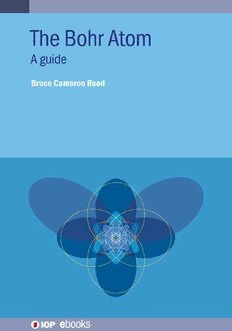Table Of ContentThe Bohr Atom
A guide
The Bohr Atom
A guide
Bruce Cameron Reed
Department of Physics (Emeritus), Alma College, Alma, MI, USA
IOP Publishing, Bristol, UK
ªIOPPublishingLtd2020
Allrightsreserved.Nopartofthispublicationmaybereproduced,storedinaretrievalsystem
ortransmittedinanyformorbyanymeans,electronic,mechanical,photocopying,recording
orotherwise,withoutthepriorpermissionofthepublisher,orasexpresslypermittedbylawor
undertermsagreedwiththeappropriaterightsorganization.Multiplecopyingispermittedin
accordancewiththetermsoflicencesissuedbytheCopyrightLicensingAgency,theCopyright
ClearanceCentreandotherreproductionrightsorganizations.
CertainimagesinthispublicationhavebeenobtainedbytheauthorfromtheWikipedia/
Wikimediawebsite,wheretheyweremadeavailableunderaCreativeCommonslicenceorstated
tobeinthepublicdomain.Pleaseseeindividualfigurecaptionsinthispublicationfordetails.To
theextentthatthelawallows,IOPPublishingdisclaimanyliabilitythatanypersonmaysufferasa
resultofaccessing,usingorforwardingtheimage(s).Anyreuserightsshouldbecheckedand
permissionshouldbesoughtifnecessaryfromWikipedia/Wikimediaand/orthecopyrightowner
(asappropriate)beforeusingorforwardingtheimage(s).
PermissiontomakeuseofIOPPublishingcontentotherthanassetoutabovemaybesought
[email protected].
BruceCameronReedhasassertedhisrighttobeidentifiedastheauthorofthisworkinaccor-
dancewithsections77and78oftheCopyright,DesignsandPatentsAct1988.
ISBN 978-0-7503-3611-6(ebook)
ISBN 978-0-7503-3609-3(print)
ISBN 978-0-7503-3612-3(myPrint)
ISBN 978-0-7503-3610-9(mobi)
DOI 10.1088/978-0-7503-3611-6
Version:20201101
IOPebooks
BritishLibraryCataloguing-in-PublicationData:Acataloguerecordforthisbookisavailable
fromtheBritishLibrary.
PublishedbyIOPPublishing,whollyownedbyTheInstituteofPhysics,London
IOPPublishing,TempleCircus,TempleWay,Bristol,BS16HG,UK
USOffice:IOPPublishing,Inc.,190NorthIndependenceMallWest,Suite601,Philadelphia,
PA19106,USA
This work is dedicated to Laurie. Again.
Contents
Preface ix
Acknowledgements xiv
Author biography xv
1 Preliminaries 1-1
1.1 On the sizes of atoms 1-1
1.2 Spectroscopy, the quantum concept, and the Balmer formula 1-2
1.3 Circular orbit forces and energetics 1-12
1.4 The radiative collapse problem 1-16
References 1-18
2 The Bohr model I: hydrogenic atoms 2-1
2.1 Niels Bohr: early life and paper I of the trilogy 2-1
2.2 The Bohr model: orbital radii and energy levels 2-6
2.3 The Bohr model: transitions and spectral series 2-10
2.3.1 The Balmer series 2-12
2.3.2 Emission and absorption 2-13
2.3.3 Other hydrogen series 2-13
2.3.4 Transition notation 2-15
2.4 Ionized helium 2-16
2.5 The Rydberg–Ritz combination principle 2-18
2.6 Angular momentum 2-19
2.7 Unpacking paper I: the correspondence principle 2-21
2.8 Initial reactions to the theory 2-24
References 2-26
3 The Bohr model II: corollaries 3-1
3.1 Orbit and energy-level diagrams 3-1
3.2 The fine-structure constant 3-3
3.3 X-rays 3-4
3.4 Overlapping and non-overlapping spectral series 3-6
3.5 Whither gravity? 3-7
3.6 The de Broglie matter-wave approach 3-7
3.7 An angular momentum/energy minimization approach 3-10
vii
TheBohrAtom
3.8 Papers II, III, and beyond: the periodic table, relativity, 3-11
and quantum mechanics
3.9 Bohr’s treatment of the H molecule 3-21
2
References 3-24
4 Miscellaneous topics 4-1
4.1 Isotope effects: deuterium 4-1
4.2 Magnetic field of the orbiting electron 4-3
4.3 Ionization potentials of two-electron atoms 4-4
4.4 Anti-hydrogen 4-6
4.5 Atomic recoil 4-7
References 4-7
5 The 1930s, World War II, fission, the bomb, and politics 5-1
References 5-8
Appendices
Appendix A A-1
Appendix B B-1
viii
Preface
Every student of physics or chemistry encounters the Bohr model of the hydrogen
atom: aloneelectron orbitsanucleus containingoneor moreprotons, restricted to
orbits whose radii are ‘quantized’ in that they are restricted to particular values.
Energy in the form of particle-like ‘photons’ is emitted to the outside world as the
electron ‘falls’ from a higher-radius orbit to a lower-radius one, or conversely
absorbsenergyfromanoutsidesourceoflightand‘jumps’toahigher-radiusorbit.
In more advanced courses, students learn that Bohr’s model was eventually super-
seded by the probabilistic particle-wave ‘quantum mechanics’ of Heisenberg,
Schrödinger,Born,Jordan,andothers.ButBohr’smodelwasthefirstmathematical
treatmentofatomicstructurewhichmadeaccuratepredictions, albeitatthecostof
introducing revolutionary ideas into physics. For these reasons alone, the place of
the Bohr model in the canon of physics is well-deserved. Beyond this, the Bohr
model stands as a superb example of how scientific theories develop. In the
beginning are well-established empirical facts; in this case regularities in spectral
features and the chemical behavior of elements. A provisional theoretical model
incorporating elements of both established physics and some new ad hoc assump-
tions is proposed, and proves surprisingly successful at ‘explaining’ some but by no
means all of the empirical facts. Tests of the theory lead to refinements, which
eventually culminate in the provisional theory being succeeded by a more complete
onewhichoftenretainstechnicaland/orconceptualelementsoftheoriginalversion.
Anonlinesearchon‘Bohratomicmodel’willreturnmillionsofhits,andthetopic
is covered in libraries of textbooks. Why did I feel that it deserves yet another
treatment? Fundamentally, there are two reasons.
First: for many years, I taught the Bohr atom in modern physics, quantum
mechanics, and astronomy classes at various levels of undergraduate physics
curricula. Curiosity drove me to read Bohr’s original papers, and I came away
from that effort with a sense that modern texts give a very narrow and incomplete
picture as to what motivated Bohr and what he actually did. For instance,
derivationsoftheBohratomoftenbeginbyassumingquantizationoftheelectron’s
orbital angular momentum, an argument which, when combined with classical
centripetalforceandenergyarguments,leadstothe‘correct’quantizedorbitalradii
and transition energies. However, this is not at all what Bohr did. Rather, his
original derivation involved two steps: a curious ‘binding-of-the-electron-to-the-
nucleus’ argument, and then consideration of orbital transitions. Both steps made
use of Max Planck’s quantum-of-radiation expression E = hf (more on this in
section1.2),butindifferentways.Thesecommentsarenotintendedtobecriticalof
texts. Such works are carefully prepared by teams of experienced, knowledgeable
authors and editors. Many scientific breakthroughs begin life convoluted and
muddled, and authors have to clean things up: it would be impossible in either a
text or class to work through every wrinkle of how a physical theory developed.
When I was a student, I recall one of my professors remarking that discoveries are
likediamonds:whentheycomeoutoftheground,theyarecoveredinmudandfull
ix

